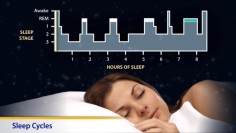
Sleep Patterns in Babies
What is a normal sleep pattern for a baby?
New sleeping patterns are one of the biggest changes caused by a new baby's arrival. New parents can have bleary eyes and sleepless nights. Getting to know your baby's schedule and communication cues takes time. Try not to feel rushed or pressured into having your baby sleep through the night or follow a specific nap schedule.
Each baby is different and has his or her own temperament and personality that affect their sleep patterns. Some babies do not sleep through the night until 1 year of age or older.
How long do most babies sleep?
Most newborns sleep an average of 16 hours a day, but this may vary from day to day and from baby to baby. Most of the time a new baby sleeps in 3 to 4 hour blocks of time. That pattern usually does not match an adult sleeping schedule. At first, babies do not know the difference between day and night. As time goes on, your baby will find his or her own internal clock to guide wake-sleep cycles. Eventually your baby will be more awake during the day and sleep longer at night.
Most babies start sleeping 6 to 8 hours at a time during the night at about 3 months of age. By 6 months of age, many babies will sleep 8 to 10 hours at night without needing to feed. If your baby is still not sleeping through the night, don't worry.
What about naps?
A baby's sleep time is divided between nighttime sleep and daytime naps. The total amount of sleep time is about the same for babies, whether they sleep for longer times, but less often, or sleep for shorter times more often. So if a baby is sleeping well at night, it is fine to let him or her nap for as long as his or her body naturally wants. If your baby isn't sleeping at night as long as you wish, it may help to wake your child from the nap early and shorten the naptime. A baby usually takes 2 naps at 6 months of age and 1 nap after 1 year of age until school age.
How can I help my baby develop good sleeping habits?
Babies learn to link certain things with sleeping. For example, if your baby is fed and always falls asleep in your arms, this may be the only way the baby is able to fall asleep. When your baby awakens during the night, he or she cannot fall back to sleep without being fed and held. Other associations may include rocking, walking, and being with you. Eventually, babies need to learn to fall asleep on their own. If your baby can fall asleep without assistance when first laid down, chances are more likely your baby will fall asleep easily after waking in the middle of the night.
After 2 months of age, you may want to encourage your baby to fall asleep without your help. Here are some ideas that may help:
- Consider feeding your baby ahead of bedtime rather than just before putting your baby to bed. Some babies do not sleep as well on a full stomach.
- Get into a regular routine at bedtime, such as a bath and quiet time 1 hour before bedtime
- Put your baby to bed drowsy but not asleep. This will help link bed with the process of falling asleep.
- Distinguish nighttime from daytime. For example, use a soft, subdued voice if you talk to your baby in the middle of the night to let the baby know it is nighttime and not time to play.
- Expect some crying as your baby falls asleep. Crying is a way for babies to comfort themselves and it may take a few minutes for the baby to find a comfortable position, settle in, and fall asleep.
- Make sure your baby is safe and comfortable. Always put your baby on his back to sleep. Keep soft objects, toys, and loose bedding out of your baby's sleep area.
- Never put a baby in bed with a bottle of milk, juice, or any sweetened liquid that can damage your baby's teeth.
- After your baby's first birthday, give him or her an object such as a stuffed animal or blanket. These things can give your child a sense of security and help him go to sleep.
Last modified: 2011-12-09
Last reviewed: 2011-09-08

